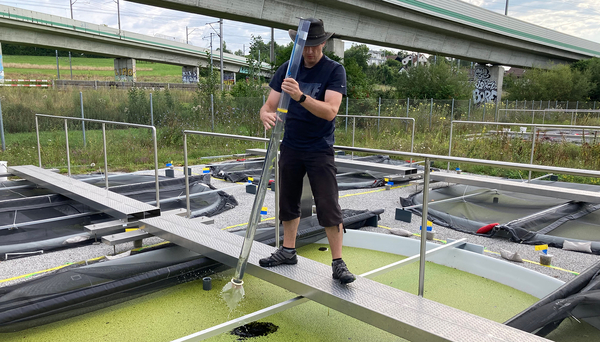News Detail
Indirect effects drive evolution
August 28, 2025 |
Natural ecosystems are intricate webs where species can interact directly, like predators and prey, or influence one another through a chain of environmental effects. But can these indirect interactions be powerful enough to permanently alter a species' genetic makeup? According to researchers at the Institute of Organismic and Molecular Evolution at Johannes Gutenberg University Mainz (JGU), the answer is a definitive yes.
In a study published on August 21st, 2025, in PNAS, an international team has demonstrated that indirect ecological effects can drive rapid evolution in aquatic communities. "We showed that land-based aphids influenced the evolution of Daphnia, a tiny aquatic crustacean, even though the two species never come into contact," stated Shuqing Xu of JGU, who led the research in collaboration with the aquatic research Institute Eawag, the University of Basel, and Clemson University. "The entire interaction is mediated by a cascade of species interactions and the shared environment, highlighting a crucial, yet often overlooked, evolutionary mechanism."
Marked differences between the genomes of the test and control groups
The researchers used various artificial ponds in the Experimental Ponds Facility of Eawag, each of which has a capacity of 15,000 liters of water. In the test ponds, they added airborne aphids, insects that feed on duckweed. The greater the extent of the infestation of the aphids on the duckweed, the lower the proliferation of the duckweed became and, as a result, the more light was able to penetrate the ponds. This resulted in an increase in the pond algae, on which the water fleas (Daphnia) feed, and that also compete with the duckweed for light and nutrients. "Despite the fact that the aphids and water fleas spend their lives in different habitats, they can indirectly affect each other," explained Xu.
Organisms living in terrestrial and aquatic habitats can influence each other through indirect ecological interactions.
Image: Shuqing Xu (icons from biorender.com)
The research team was specifically interested in how the activities of the aphids impacted on the water fleas. They took water samples every two weeks and analyzed parameters such as temperature, nutrition, and oxygen levels. In addition, they documented the concentrations of aphids, duckweed, algae, and water fleas. "We put together a continuous record of changes in the ponds. In the second year of our experiment, we documented an increase in the water flea population that had access to more nutrition because of the improved growth of the algae," pointed out Christoph Vorburger, head of the Evolutionary Ecology group of Eawag's Department of Aquatic Ecology.
In order to track evolutionary changes in the water fleas, the researchers compared the genomic sequences of the water fleas between control and aphid ponds. "We found marked differences at many genome locations," added Antonino Malacrinò, a former group leader in the team of Professor Xu and now an assistant professor at Clemson University in the USA. "The evolution of the water fleas in the test and control ponds was taking two different directions – an effect attributable to the presence and the absence of the aphids."
Evolutionary adaptations and their costs
The researchers also studied whether evolutionary effects caused by the insects led to corresponding adaptations of the water fleas to their environment. For this purpose, they translocated water fleas from each test pond into a control pond and vice versa. They observed that the water fleas from the "aphid ponds" did not cope well in the control ponds. On the other hand, the water fleas from the control ponds had no difficulties acclimatizing to the conditions in the aphid ponds. "The adaption of the water fleas to the environment with the aphids came with a price," concluded Martin Schäfer, a member of Xu's team. The researchers also looked at whether there were feedback effects on the aphids resulting from the changes to the aquatic community. They found that the increase in temperatures and concentrations of nutrients and water fleas had a positive effect on the aphid population.
Findings from pure research in the laboratory are not always 100% transferable to naturally occurring water bodies. Eawag has therefore constructed a number of experimental ponds in an area close to the “Aquatikum” experimental hall in Dübendorf. The ponds contain mini-ecosystems which are exposed to natural weather conditions. The researchers are able to influence and control these systems for experimental purposes, which enables them to find answers to questions on biodiversity and on how ecosystems function – questions which could not be answered by studying what happens in a test tube.
More about the experimental ponds
These findings are set to prompt a fundamental rethinking of approaches in evolutionary biology, a field that has historically focused on direct interactions and largely ignored indirect effects.
"We have now been able for the first time to directly demonstrate that species that do not actually come into contact can influence the evolution of each other," stated Xu. "If research continues to pay insufficient attention to this factor, it will become difficult to apply laboratory findings to real-world ecosystems. For example, it is clearly an oversimplification to study terrestrial and aquatic ecosystems in isolation."
Xu emphasized that the study was only made possible through strong international collaboration. The initial concept was developed by his team of duckweed experts in Mainz. Colleagues from the University of Basel contributed their leading expertise on water fleas, while the Eawag team provided essential know-how on aquatic systems. Vorburger adds how important Eawag's experimental pond facility was for this project. ‘It was only thanks to the possibility of replication on a large and therefore realistic scale that it was possible to demonstrate such indirect effects across habitat boundaries.
Cover picture: Martin Schäfer taking a water sample from one of the test ponds (Photo: Christoph Walcher, Eawag).
Publication
M. Schäfer et al., Aphid herbivory on macrophytes drives adaptive evolution in an aquatic community via indirect effects, PNAS, 21. August 2025, DOI: 10.1073/pnas.2502742122,
https://www.pnas.org/doi/10.1073/pnas.2502742122


